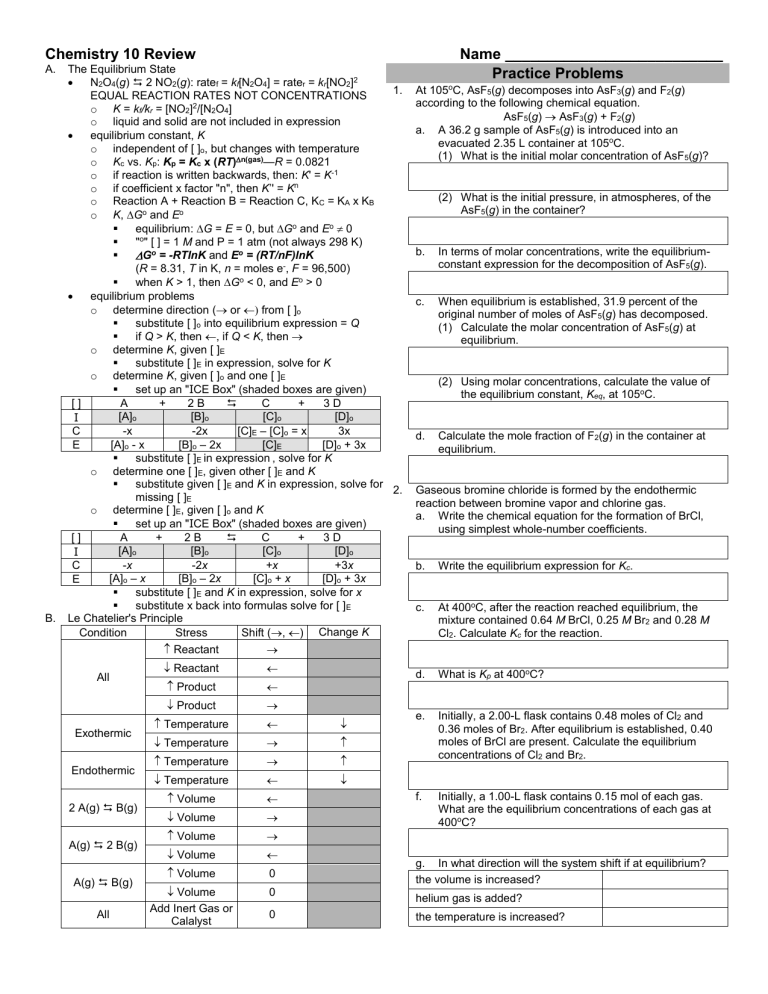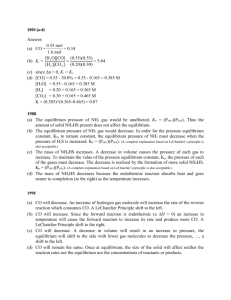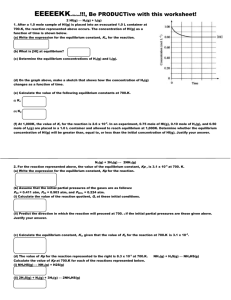AP Chemistry

Chemistry 10 Review
A. The Equilibrium State
N
2
O
4
( g )
2 NO
2
( g ): rate f
= k f
[N
2
O
4
] = rate r
= k r
[NO
2
] 2
EQUAL REACTION RATES NOT CONCENTRATIONS o K = k f
/k r
= [NO
2
] 2 /[N
2
O
4
] o liquid and solid are not included in expression
equilibrium constant, K o o independent of [ ]
K c o
, but changes with temperature
vs. K p
: K p
= K c
x (RT)
n(gas) —
R = 0.0821 o if reaction is written backwards, then: K ' = K -1 o if coefficient x factor "n", then K
’' =
K n o Reaction A + Reaction B = Reaction C, K
C o K ,
G o and E o
= K
A
x K
B
equilibrium:
G = E = 0, but
G o and E o
0
" o " [ ] = 1 M and P = 1 atm (not always 298 K)
G o = -RTlnK and E o = (RT/nF)lnK
( R = 8.31, T in K, n = moles e , F = 96,500)
when K > 1, then
G o < 0, and E o > 0
equilibrium problems o determine direction (
or
from [ ] o
substitute [ ] o
into equilibrium expression = Q
if Q > K , then
, if Q < K , then
o determine K , given [ ]
E
substitute [ ]
E
in expression, solve for K o determine K , given [ ] o
and one [ ]
E
set up an "
I
CE Box" (shaded boxes are given)
[ ] A + 2 B
C + 3 D
I [A] o
[B] o
[C] o
[D] o
C
E
-x
[A] o
- x [B]
-2x o
– 2x
[C]
E
– [C]
[C]
E o
= x 3x
[D] o
+ 3x
substitute [ ]
E in expression , solve for K o determine one [ ]
E
, given other [ ]
E
and K
substitute given [ ]
E
and K in expression, solve for missing [ ]
E o determine [ ]
E
, given [ ] o
and K
set up an "
I
CE Box" (shaded boxes are given)
[ ] A + 2 B
C + 3 D
I
[A] o
[B] o
[C] o
[D] o
C
E
x -2 x +x +3 x
[A] o
– x [B] o
– 2 x [C] o
+ x [D] o
+ 3
substitute x back into formulas solve for [ ]
E x
substitute [ ]
E
and K in expression, solve for x
B. Le Chatelier's Principle
Condition Stress Shift (
,
) Change K
Reactant
Reactant
All
Product
Product
Temperature
Exothermic
Endothermic
Temperature
Temperature
Temperature
2 A(g) B(g)
A(g)
A(g)
2 B(g)
B(g)
All
Volume
Volume
Volume
Volume
Volume
Volume
Add Inert Gas or
Calalyst
0
0
0
Name __________________________
Practice Problems
1. At 105 o C, AsF
5
( g ) decomposes into AsF
3
( g ) and F
2
( g ) according to the following chemical equation.
AsF
5
( g )
AsF
3
( g ) + F
2
( g ) a. A 36.2 g sample of AsF
5
( g ) is introduced into an evacuated 2.35 L container at 105 o C.
(1) What is the initial molar concentration of AsF
5
( g )?
(2) What is the initial pressure, in atmospheres, of the
AsF
5
( g ) in the container? b. In terms of molar concentrations, write the equilibriumconstant expression for the decomposition of AsF
5
( g ). c. When equilibrium is established, 31.9 percent of the original number of moles of AsF
5
( g ) has decomposed.
(1) Calculate the molar concentration of AsF
5
( g ) at equilibrium.
(2) Using molar concentrations, calculate the value of the equilibrium constant, K eq
, at 105 o C. d. Calculate the mole fraction of F
2
( g ) in the container at equilibrium.
2. Gaseous bromine chloride is formed by the endothermic reaction between bromine vapor and chlorine gas. a. Write the chemical equation for the formation of BrCl, using simplest whole-number coefficients. b. Write the equilibrium expression for K c
. c. At 400 o C, after the reaction reached equilibrium, the mixture contained 0.64 M BrCl, 0.25 M Br
2
and 0.28 M
Cl
2
. Calculate K c
for the reaction. d. What is K p
at 400 o C? e. Initially, a 2.00-L flask contains 0.48 moles of Cl
2
and
0.36 moles of Br
2
. After equilibrium is established, 0.40 moles of BrCl are present. Calculate the equilibrium concentrations of Cl
2
and Br
2
. f. Initially, a 1.00-L flask contains 0.15 mol of each gas.
What are the equilibrium concentrations of each gas at
400 o C? g. In what direction will the system shift if at equilibrium? the volume is increased? helium gas is added? the temperature is increased?










